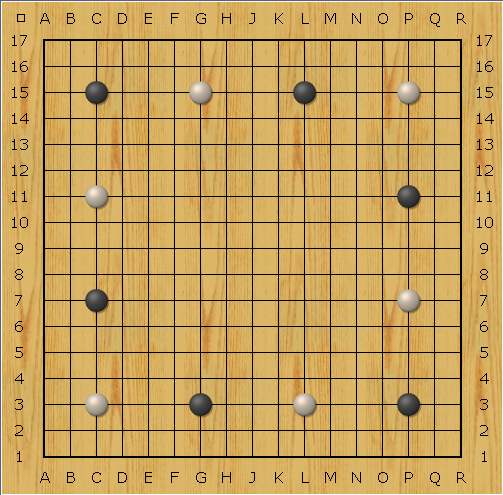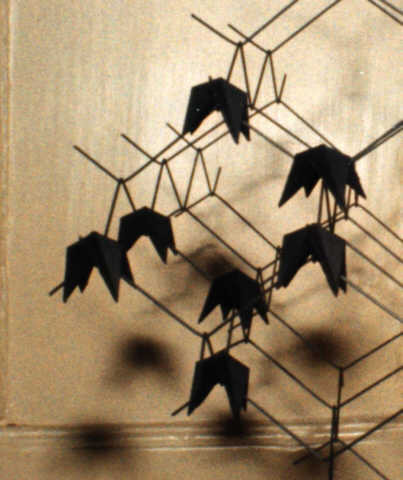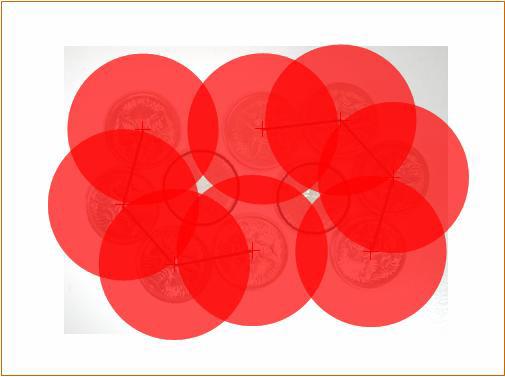Go - unknown lands
unreliable areas, disputed areas,
intersecting terrain, hubs,
difficult terrain, trap terrain,
surrounded by terrain and deadly terrain.
Sun Tzu "The Art of War "
There are people who are tired of all the usual. In their search for the new, they make discoveries, invent, create. They make our life better, in all its manifestations. Guo is no exception.
Introductory note
The material in this article assumes that the reader is familiar with the basic concepts of the Go game. Those interested can familiarize themselves with them by reading the previous articles of the cycle:
')
')
When it comes to playing on non-standard boards, increasing the dimension is the first thing that comes to mind. Three, four and, moreover, five-dimensional boards (or rather, their projections, as a rule, on a plane) make a strong impression on others and allow players to amuse their own ego. Unfortunately, a full-fledged game of Go, on such boards, is fraught with a number of problems. Not to mention that the orientation on high-dimension boards is difficult, such radical changes seriously break the game balance:
This game does not look interesting. I see two reasons for this. First, positions on such a board have (maximum) six, and not four neighbors. As a result, it becomes much more difficult to completely surround some territory (or a group of stones). More problems arise with "cutting." In order to cut a straight line, one point is enough, but the plane will need to be cut straight already! All this together makes the survival of groups too simple, and the seizure of territory (the goal of the game), on the contrary, is unnecessarily difficult.
Obviously, a further increase in dimension will further aggravate the problems described above. But what happens if you reduce the dimension? According to the rules, Go can be played on a one-dimensional board. This option has its own problems. On a one-dimensional board it is impossible to build a group with an “eye” (only two groups can be built, separating one “eye”). Moreover, it is impossible to build two “eyes”, thus ensuring the life of the group. Any group without two “eyes” can be surrounded and captured.
To achieve a final victory, on such a board, is possible only in one way. It is necessary to fill the entire board with your groups in such a way that each group is separated from the other by exactly one empty board field. End fields of the board must also remain free. In this case, the enemy will not be able to take any of the empty fields, since such a move, which does not lead to the seizure of stones, will be considered suicidal. Incidentally, this limiting case shows that, in some cases , groups without two true “eyes” may remain alive.
AK Dewdney , in his description of the possible existence of two-dimensional creatures " The Planiverse " rather successfully solved the problem described above. The main difference of the Alak game is that by closing the last “breathing point”, the player does not kill his group. Such a move is not suicidal and allows you to start surrounding the nearby enemy group. The resulting game is very interesting not only in theoretical but also in practical terms. You can already play it:
Similar rules make Alak more like “Clamping” games such as Seega and Hasami Shogi . In these games, the opponent’s pieces are “taken” by surrounding them from two opposite sides, but by standing between the opponent’s pieces under their own power, the piece is safe. The similarity becomes even more obvious if you allow the movement of figures:
The natural continuation is a game on 2xN boards . This is, in principle, already two-dimensional, but still extremely non-standard form. Here live groups with two “eyes” are already possible, but since both lines, in Go terminology, are “death lines”, it is still hard to play on such a board. Such variants are useful, first of all, because they allow a better understanding of classical Go. The border of the board is very important! If you remove it, the game will change radically. In a sense, it (by necessity) will turn into " Cosmic Go " with the game for influence, and not for territory.
Adding new borders to the board is even more interesting. Such a board "with holes" greatly diversifies the tactical component of the game. You can change the very nature of the borders, making them "friendly" for the players. Using the initial set-up (instead of starting the game on an empty board) also carries many interesting possibilities . In particular, the initial placement was used in “ Tibetan Go ”, which introduced, in addition, additional rules limiting the possibility of moving away from their pieces and scoring extra points for certain points on the board.

Even a simple resizing of the board can bring both tactical and strategic diversity into the game. Particularly interesting in this respect are boards with an even number of lines. But the game of Go is not limited to only rectangular boards! Hexagonal boards are also not without their appeal. Problems with them are similar to those that arose when using multi-dimensional boards. There are too few neighbors on the trigonal board, there are already too many on the hexagonal board. In addition, the diagonal on the hexagonal board (as opposed to the usual one) is not able to cut anything!
Such balance deficiencies can be tried to be corrected by changing the rules of the game. For example, in " TriGo " the order of moves is changed. The first player walks with one stone, then, for each turn, two stones are laid out. In addition, such a move system also somewhat weakens the advantage of the first player, due to which the Komi system had to be introduced in classic Go. In this article , the hexagonal board is proposed as a means of combating Ko , but the problem is clearly not worth the sacrifice that this “solution” brings with it. Moreover, Ko can still occur in more complex cases, for example, when playing more than two players:
Black and gray can continue to play in turn in the same positions indefinitely. Of course, the case is also not limited to hexagonal boards. More fancy nets can be used for the game. Quite interesting is the three-dimensional board, which repeats the scheme of connecting atoms in the diamond crystal lattice. On this board, as well as on the classic one, each field has from two to four neighbors (the minimum configuration with two “eyes” is shown in the photo below):

Playing on such a board “live” may not be very convenient. Fortunately, there is a wonderful free program that allows you to play (including on the network) on almost any board:
Its interface may seem inconvenient (after CGoban , for example), but everything you need (including manual removal of "dead" stones and scoring) in it is available. In addition, it is quite easy to create your own board :
This is the description of the dodecahedron
20 0.369927 3 8 13 18 0.598555 0.100627 -0.840481 3 13 2 7 -0.598555 0.100628 -0.840481 3 1 17 15 -0.968482 -0.228628 -0.290819 3 9 18 19 0.968482 0.228625 0.290819 3 19 16 6 0 0.307733 0.99 3 7 6 17 -0.598553 0.840481 0.100626 3 4 9 5 0 0.889374 0.532739 3 1 8 5 -0.369927 0.761373 -0.598554 3 9 0 7 0.369927 0.761373 -0.598553 3 6 3 8 0.598551 0.840481 0.100626 3 11 18 14 0.598556 -0.840481 -0.100628 3 12 19 10 0.369927 -0.761375 0.598554 3 15 11 16 -0.369926 -0.761375 0.598553 3 14 1 0 0 -0.307734 -0.99 3 15 10 13 0 -0.889374 -0.532748 3 2 14 12 -0.598555 -0.840482 -0.100627 3 12 17 4 -0.598554 -0.100628 0.840481 3 5 2 16 -0.968482 0.228627 0.290817 3 0 3 10 0.968482 -0.228627 -0.29082 3 3 4 11 0.598554 -0.100627 0.840481 But this "unknown land" does not end there. You can refuse the board’s discreteness itself and play on the “board without lines”. In this version of the game, the figures can be placed anywhere on the plane, and the “neighborhood” of the figures can be determined, for example , through the Euclidean distance . This game really requires accuracy. The barely noticeable movement of a piece from its position can drastically change the character of the position.

It looks like a living form. The voids in it are two “eyes” in which you can “squeeze” figures of your own color (the opponent cannot do this, since such moves will be considered suicidal). Obviously, this game is “an amateur” and this is perhaps the strangest version of the Go game known to me. There is another game that “expands” the rules of Guo, which I like more than all of the above, but this is a topic for a separate article.
Source: https://habr.com/ru/post/365671/
All Articles